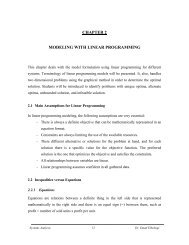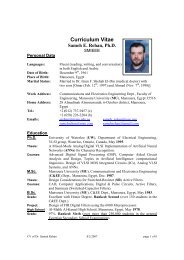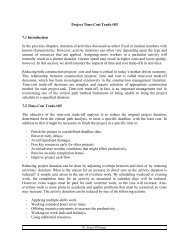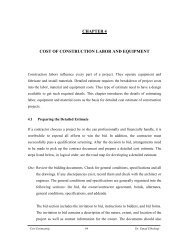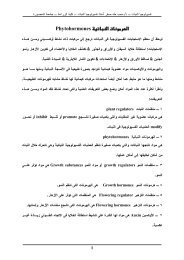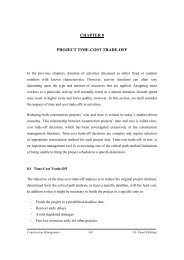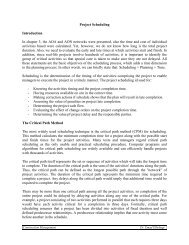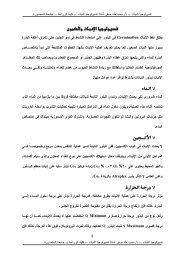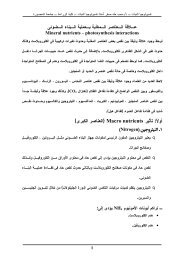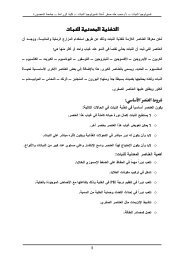Thyroid and Parathyroid
Thyroid and Parathyroid
Thyroid and Parathyroid
You also want an ePaper? Increase the reach of your titles
YUMPU automatically turns print PDFs into web optimized ePapers that Google loves.
goiter (2 percent versus 0.5 percent), because all of the central neck fibroadipose <strong>and</strong><br />
lymphatic tissue should be removed in patients with medullary carcinoma. After most<br />
operations the serum calcium level falls by about 1 mg/dL. Symptomatic<br />
postoperative hypoparathyroidism after thyroidectomy usually is transient <strong>and</strong><br />
resolves in most cases within a few days without treatment <strong>and</strong> with calcium<br />
supplementation when treatment is necessary. When the serum phosphorus level is<br />
low or normal, there is less concern in the hypocalcemic patient than when it is high,<br />
. because the latter suggests hypoparathyroidism<br />
In most instances, postoperative hypoparathyroidism is a result of parathyroid<br />
ischemia from bruising <strong>and</strong> partial interruption of parathyroid blood supply. This<br />
situation can be avoided by dissection along the thyroid capsule <strong>and</strong> gently teasing the<br />
parathyroid gl<strong>and</strong> on a broad plane of tissue away from the thyroid gl<strong>and</strong> in a<br />
posterolateral direction. This decreases the risk of disruption of the parathyroid blood<br />
supply, derived from the inferior <strong>and</strong> superior thyroid arteries. Hypoparathyroid<br />
patients usually exhibit early tingling <strong>and</strong> numbness around the lips, followed by the<br />
same sensation in the fingers. A positive Chvostek's sign (twitching of the lips after<br />
tapping over the facial nerve) is usually present. When hypocalcemia is not treated,<br />
patients may progress to carpopedal spasm. Symptoms occur when the calcium level<br />
falls below 8 mg/dL. Hypocalcemia also increases anxiety <strong>and</strong> respiratory alkalosis.<br />
Hyperventilation can cause tetany with or without associated hypocalcemia. Patients<br />
with postoperative hypocalcemia are treated initially with approximately 1 g of<br />
calcium every 4 h if symptomatic. When the serum calcium level remains low,<br />
intravenous calcium (1 to 10 ampoules of calcium gluconate or calcium chloride) can<br />
be given over several hours. Extravasation into the subcutaneous tissues can cause<br />
tissue necrosis. Treatment with calcitriol (Rocaltrol) 0.25 to 1.0 mg twice daily is<br />
occasionally necessary. In patients with persistent symptoms, the serum magnesium<br />
. level should be evaluated<br />
Postoperative Management of Differentiated <strong>Thyroid</strong> Cancer<br />
<strong>Thyroid</strong> Hormone<br />
After thyroid surgery for carcinoma, patients should be placed on thyroxine. This is<br />
necessary as replacement therapy in patients who have undergone total thyroidectomy<br />
but has the additional effect of suppressing TSH <strong>and</strong> reducing the growth stimulus to<br />
any possible residual thyroid cancer cells. TSH suppression reduces tumor recurrence<br />
rates, particularly in patients with papillary cancer. Thyroxine should be administered<br />
to ensure that the patient remains euthyroid, with circulating TSH levels about 0.1<br />
. mU/L in low-risk patients or less than 0.1 mU/mL in high-risk patients<br />
Thyroglobulin Measurement<br />
Thyroglobulin levels in patients who have undergone total thyroidectomy should be<br />
below 2 ng/mL when the patient is taking thyroxine, <strong>and</strong> below 3ng/ml when the<br />
patient is not taking thyroxine. A thyroglobulin level above 3 ng/mL is highly<br />
suggestive of metastatic disease or persistent normal thyroid tissue, especially if it<br />
increases when TSH levels increase when thyroid hormone treatment is discontinued<br />
in preparation for radioiodine scanning. In this situation, radioiodine scan should be<br />
. performed<br />
About 95 percent of patients with persistent or recurrent thyroid cancer of follicular<br />
cell origin will have thyroglobulin levels higher than 3 ng/mL. High- risk patients



